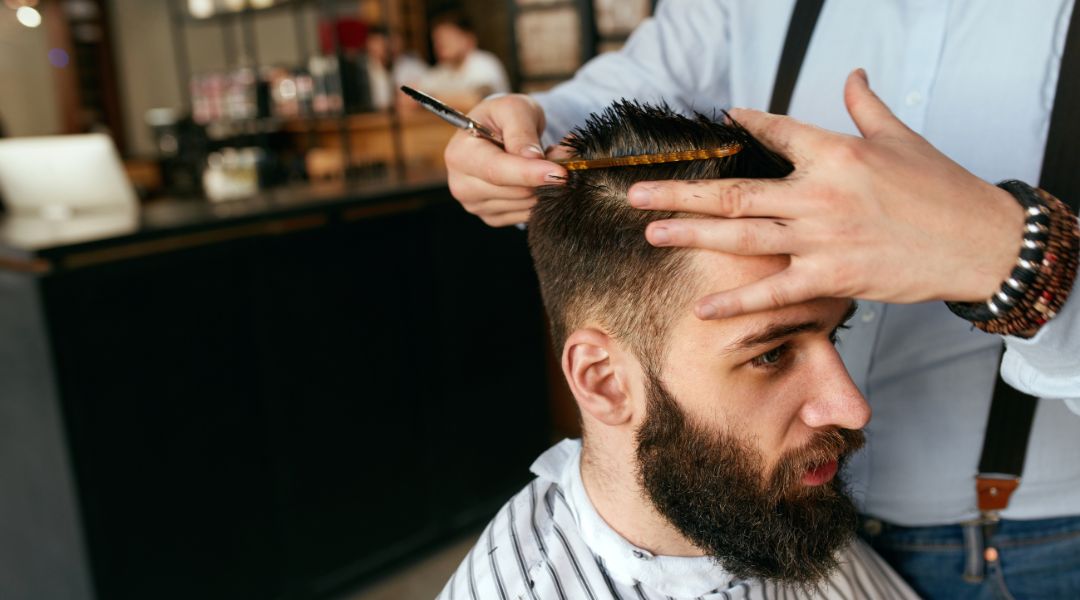Deciding between a career as a barber or hairdresser? You’re contemplating professions steeped in tradition, artistry, and personal connection. Each path offers unique techniques for styling and caring for hair but requires distinct skill sets.
As you weigh your options, consider Texas Barber College, renowned for excellence in education. At our institution, aspiring professionals master the craft of barbering with hands-on experience to excel beyond industry standards, a step toward becoming one of the best-trained barbers in Texas.
Defining Barbers and Hairdressers
Barbers and hairdressers both shape your look but in different ways. You might pick a barber for their skill with men’s cuts or beard care. They train hard in these areas. Often, barbers offer that extra touch. Think hot towel service during a fresh shave.
If you’re after color treatments or complex styles, though, a hairstylist at the salon is more up your alley.
Historical Context of Barbering
Barbering traces back to a time when barbers were the original community leaders and medicine men. In ancient tribes, they held significant roles in shaping society by warding off evil spirits. During Roman times, not having a beard was considered high status, and only “barbarians” kept them. Hence, barber shops became places of influence.
Later on in history, hairdressing emerged from European social trends during the 17th century as opulent hairstyles demanded professional attention. Unlike hairstyling, which evolved with fashion over centuries, barbering provided foundational services essential for societal development, like surgery and grooming. Today, you expect your barber to offer more than basic grooming. Beard trims and wet shaves are specialties not shared by hairdressers.
The Services: Cut, Shave, Style
Barbers master short, classic cuts using clippers. They’re skilled in blends and fades. Salons cater to longer styles with scissors. For a straight-razor shave, a barber’s exclusive, you’ll find no match at salons. Choose barbers for their precision in men-specific haircuts and treatments like beard trims or hot lather shaves, which is their trademark service.
If you have eye color or trendy long locks, seek stylists. They lead on current fashion shifts and excel with scissors work over clipper techniques. Unlike most barbers who rarely venture into dyeing hair or other chemical services, hairstylists shine here, offering expansive care beyond simple cutting. Think sculpted styling plus tailored product advice.
Key Differences in Training Focus
When choosing who’ll cut your hair, consider the key differences in their training. Barbers focus on men’s cuts. Think buzzcuts and fades, and give a clean look without much product. They also offer treats like hot lather shaves, something to try for that special smooth feel.
Stylists get deeper into styling, often suggesting trendy looks during consults that suit you best. If color is what you’re after or if longer locks need shaping up, stylists shine here, too. They understand coloring well and play with more products than most barbers might stock. Remember, though, these lines can blur with professionals adept at both fields!
Licensing and Certifications Compared
When you’re eyeing a career in hair, grasp this: barbers cater mainly to men’s grooming needs. Think cuts and beard trims. In contrast, cosmetologists offer more. They handle skin treatments and nail care like manicures and pedicures, waxing, and hair styling. Separate paths mean different licenses.
States run their own barber and beauty boards. So, rules vary by location. You’ll need the right business license plus insurance fitting your service range for legal work as a professional.
Can cosmetologists join barbers? Sure thing, as long as there’s also a licensed barber on site! Remember to check state specifics before diving into any role fully equipped with knowledge!
Choosing Your Craft: Considerations for Prospects
As you weigh your options between becoming a barber or hairdresser, think about what suits you. Barbers often gear their skills toward men’s grooming. Think shortcuts and shaves. Hairdressers usually train more broadly, styling long hair and coloring, too.
Look at job demand in your area; barbershops might be on every corner, or maybe salons are the big thing. Remember, each has its own vibe: barbering is laid-back, while salon work can get high-energy fast! Both paths need firm people skills since good talk makes most clients come back.
Check local rules. Some places let barbers do colors after extra classes. So ask yourself, where does your passion lie? What feels right for you could just be the best call to make.
Spotlight on Texas’s Top Barber Schools
In Texas, top barber schools set you up for success. You’ll dive deep into cutting, styling, and coloring techniques made just for barbers. Think clipping more than scissors; buzzers over blow dryers.
These schools prepare you to be great at shorter cuts, but that’s not all. They also train on skincare and handling straight-edge razors like a pro—skills hair stylists may not have. Your time in these programs is valuable. They teach what sets barbers apart from hairdressers: specialty skills men often seek out when they want a clean shave or the perfect beard trim done right.
Enroll now if this craft calls your name!
When you choose between a barber and a hairdresser, consider your needs. Barbers specialize in traditional men’s cuts and facial hair grooming, perfect for classic styles or beard maintenance. Hairdressers offer more varied services suitable for all genders, excelling in longer hairstyles and color treatments.
At Texas Barber College, we focus on crafting barbers with precision skills tailored to masculine styling while educating them about the broader aspects of haircutting techniques that apply across various client preferences.

